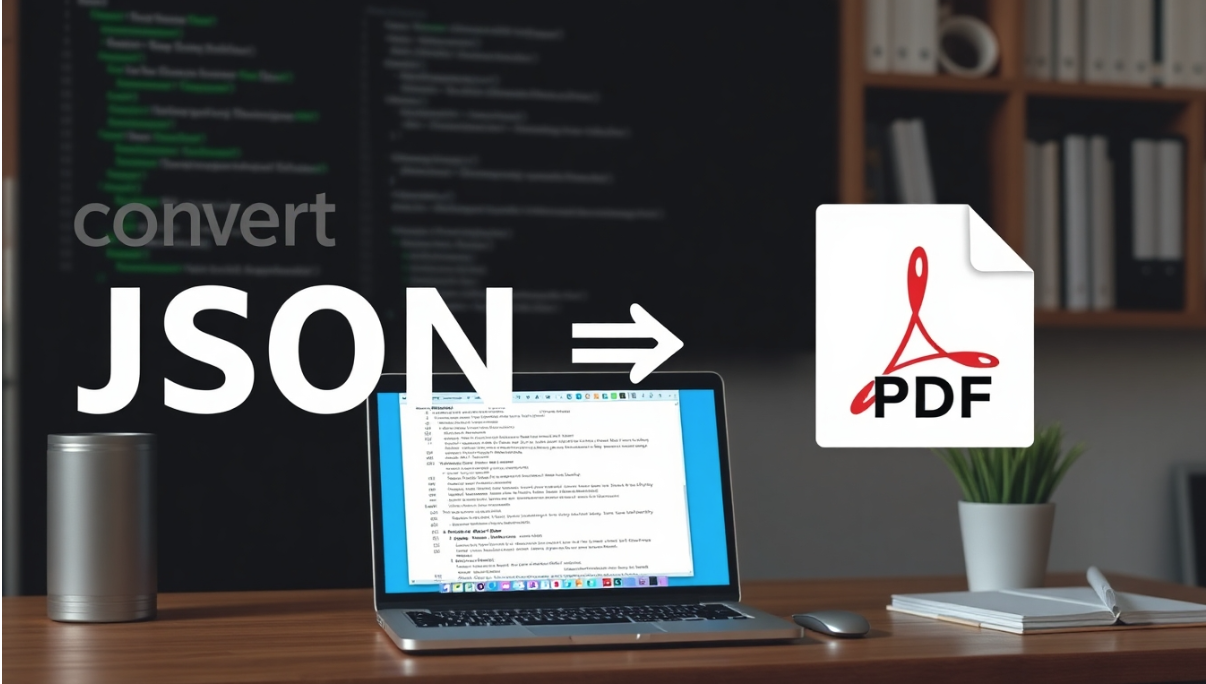How to Automate Report Generation: Converting JSON Data to Professional PDF Documents for Business Workflows
Business systems generate JSON data continuously from sales, CRM, and analytics platforms. Manual report creation from this structured data consumes valuable resources and introduces human error risks. Organizations struggle to transform raw JSON into presentation-ready documents efficiently. Companies need reliable automation solutions to json to pdf conversion for streamlined reporting workflows.
This comprehensive guide provides IT professionals with practical automation strategies. Each section addresses implementation challenges and provides actionable solutions.

JSON to PDF Conversion Fundamentals for Business Automation
JSON data powers modern business applications but requires transformation for stakeholder consumption. Converting structured data into professional documents streamlines reporting workflows significantly.
Why JSON to PDF Conversion Matters
Data accessibility for non-technical stakeholders drives conversion requirements. Executives and managers need readable reports without technical expertise. PDF format ensures consistent presentation across different devices and platforms.
Professional presentation requirements mandate polished document formatting. Business stakeholders expect branded, well-structured reports. Raw JSON data lacks visual appeal and readability for decision-making purposes.
Archival and compliance needs require standardized document formats. PDF ensures long-term accessibility and legal admissibility. Regulatory requirements often specify PDF format for official documentation.
Common Business Use Cases
Financial reporting automation generates periodic statements and analyses. Monthly revenue reports, expense summaries, and budget comparisons require regular production.
Customer data summaries consolidate information from multiple sources:
- CRM systems and support tickets
- Transaction histories and purchase patterns
- Account status and billing information
- Communication logs and preferences
Inventory management reports track stock levels and movement patterns. Performance analytics dashboards convert metrics into executive presentations automatically.
Planning Your Automated Reporting System
Successful automation requires careful planning and system design. Understanding data sources and output requirements guides implementation decisions effectively.
Data Structure Analysis
JSON schema validation ensures consistent input data formatting. Establish clear data structure requirements before implementation begins. Document all expected fields, data types, and validation rules comprehensively.
Data mapping requirements connect JSON fields to PDF elements. Create detailed mapping specifications for each report type. Include field transformations, calculations, and formatting rules in documentation.
Nested object handling manages complex data hierarchies effectively. Array processing considerations address repeating data elements like customer lists and transaction records.
Output Format Requirements
Business branding guidelines ensure consistent corporate identity presentation. Company logos, color schemes, and typography must appear consistently. Create reusable templates incorporating all branding elements properly.
Layout and formatting standards maintain professional document appearance:
- Establish margins, spacing, and font size rules
- Define alignment and typography standards
- Create consistent header and footer formats
- Implement table and chart formatting guidelines
Chart and visualization needs transform numeric data into graphical representations. Template design considerations balance flexibility with consistency requirements.
Implementation Strategies for JSON to PDF Automation
Multiple approaches exist for automating JSON to PDF conversion. Each method offers different benefits depending on technical requirements and business constraints.
API-Based Solutions
RESTful service integration provides scalable conversion capabilities. Cloud-based APIs handle processing without infrastructure investment. Services offer professional-grade conversion with minimal implementation effort.
Authentication and security protocols protect sensitive business data. API keys, OAuth tokens, and encryption ensure data privacy. Implement proper security measures according to data protection standards.
Rate limiting considerations prevent service overload and cost overruns. Error handling protocols ensure reliable operation under various conditions.
Workflow Integration Options
Scheduled batch processing handles large volumes efficiently. Daily, weekly, or monthly report generation suits many business needs. Batch processing optimizes resource utilization and reduces processing costs.
Real-time conversion triggers respond to immediate reporting needs. Event-driven systems generate reports when specific conditions occur. Manual override capabilities provide flexibility for exceptional situations.
| Integration Type | Best For | Considerations |
| Batch Processing | High Volume | Resource optimization |
| Real-time | Immediate needs | Performance impact |
| Event-driven | Automated workflows | System complexity |
| Manual Override | Ad-hoc requests | User interface needs |
Technical Implementation Best Practices
Professional results require attention to technical details. Following established practices ensures reliable, scalable automation systems.
Data Validation and Sanitization
Input validation protocols prevent processing errors and security vulnerabilities. Validate all JSON data against established schemas before conversion. Reject malformed or incomplete data with appropriate error messages.
Error handling procedures manage exceptions gracefully without system failure. Data cleansing techniques ensure consistent formatting and accuracy. Security considerations protect sensitive business information throughout processing.
Performance Optimization
Batch processing strategies maximize throughput while minimizing resource consumption. Memory management prevents resource exhaustion during large report generation. Processing speed optimization reduces report generation time significantly.
Resource utilization monitoring ensures optimal system performance:
- Track CPU usage and memory consumption
- Monitor disk I/O patterns and network traffic
- Implement alerting for resource thresholds
Creating Professional PDF Output
Business documents require professional appearance and functionality. Proper formatting enhances document usability and stakeholder acceptance significantly.

Design and Layout Considerations
Corporate branding integration maintains consistent company identity across all reports. Typography and spacing enhance readability and professional appearance. Table and chart formatting presents data clearly and attractively.
Page layout optimization ensures efficient use of available space. Balance text density with white space for optimal readability.
Advanced Features Implementation
Interactive elements enhance user engagement and document functionality. Hyperlink integration connects related information and external resources. Bookmark navigation improves document accessibility for large reports.
Metadata inclusion supports document management and searchability. Include author information, creation dates, and document descriptions effectively.
Monitoring and Maintenance
Automated systems require ongoing monitoring and maintenance. Proactive management prevents failures and ensures consistent performance throughout system lifecycle.
System Monitoring
Performance metrics tracking identifies trends and potential issues. Monitor processing times, error rates, and resource utilization patterns. Error rate monitoring prevents service degradation and user frustration.
Processing time analysis optimizes system performance and user experience.
Maintenance Protocols
Regular system updates ensure security and performance optimization. Apply security patches, software updates, and configuration improvements. Schedule maintenance windows to minimize business impact.
Data backup procedures protect against information loss and system failures. Store backups securely according to data retention policies.
Conclusion
Automated JSON to PDF conversion transforms business reporting workflows significantly. Implementation requires careful planning, proper technical execution, and ongoing maintenance. Professional results depend on attention to both technical and business requirements.
Organizations investing in automation realize substantial efficiency gains and cost savings. Consistent, high-quality reports improve decision-making and stakeholder satisfaction. Begin automation implementation with pilot projects and expand systematically.
